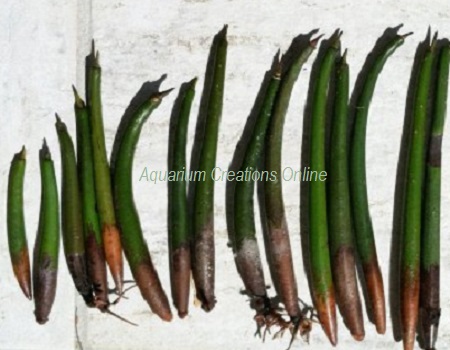Red Mangrove Plant, Red Mangrove Propagules, Aquacultured

Our Clean Macroalgae is aquacultured in large vats not connected to any fish system to avoid possible parasite or bacteria contamination. You can place our macroalgae directly in your tank without worry.
Description
Red Mangrove Seeds are correctly called Red Mangrove Propagules. When compared to Red Mangrove Plants, the Red mangrove propagules are easier to have success with and have better growth rate in the aquarium. By growing the Red Mangrove Propagules into Mangrove Plants it helps maintain pristine aquarium water quality. It provides the perfect marine habitat for mandarins, seahorses, for all of your fish, shrimp, amphipods, copepods, snails, crabs, shrimp and more.
The Red Mangrove, Rhizophora mangle, is a true marine plant that is suitable for any saltwater aquarium that can provide the needed light. Their plants are grown from their propagules which are the seed of the red mangrove tree. The purchase size of red mangrove propagules range from 6 to 9 inches with a colors somewhere between bright green and brown. Normally there are more than enough nutrients/minerals in the aquarium water to support the species, however the regular replenishment of trace elements will boost growth.
Rhizophora mangle is a strong and tough mangrove, able to grow in different climates. They can handle changing humidity, salinity, air and water temperature, and its propagule's will survive for up to a year floating in the ocean. Rhizophora mangle can grow either on or in nearly any sort of substrate and as its root system develops, it enriches the refugium habitat. The plant tolerates poor water quality and weak water movement. However, it does require strong lighting. Some natural sunlight (like through a window) will greatly benefit the red mangrove plant.
Aquacultured red mangrove plants are highly preferable to harvested wild specimens. Being aquacultured they are well adapted to aquarium life, more able to handle shipping stress, and unlikely to carry any pests. Red Mangrove plants and propagules are held in Aquarium Creations plant specific system. This closes the loop as it reduces the risk of transfer of fish parasites and unwanted hitchhikers.
Difficulty to Grow:Easy
Reef Safe:Yes
Lighting Requirements:Provide 100 to 150 watts of 5100K to 6700K lighting or equivalent fluorescent lighting to thrive. It is important to promote a good growth rate, as the harvested plants are what removes the nutrients from the aquarium ecosystem. Faster plant growth will allow for more frequent harvesting, which will in turn increase the filtration benefit of the Saltwater Plants.
Waterflow:Able to be grown in slow to high water flow.
Water Parameters:72-82° F, dKH 8-12, pH 8.1-8.4, sg 1.023-1.026
Supplements: Magnesium, Trace Elements, Iron
Care Info.. Float the unopened saltwater plant bag in the aquarium for 30 minutes to 1 hour to allow the temperatures to equalize. Then place in your tank, sump, or refugium. Trim back your plants periodically to directly remove the absorbed toxins from your water.
|
|
Copyright 2019 Aquarium Creations Online
Photos are representative of each species. All marine life will be unique and variations should be expected, color and sizes may vary.
*Guarantee Restriction: All of our livestock are guaranteed. However for one or more of these species, they may be marked with a guarantee restriction. If it does, it means the specific animal may not handle stress from environmental conditions well. These stresses can include poor water quality, harassment from tank mates or confined aquarium conditions. When stressed, these species can lose the ability to ward off infection and disease. Other species may be listed as Restricted because they have such specialized feeding requirements that is difficult recreate in a aquarium and may succumb to malnutrition.
|
|

